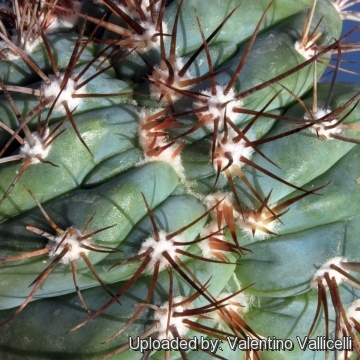Accepted Scientific Name: Melocactus azureus Buining & Bredero
Kakteen Sukk. 22: 101, figs. 1971

Melocactus azureus f. cristatus Photo by: Valentino Vallicelli
Origin and Habitat: Garden origin (Nursery produced cultivar) The wild species comes from central and northern Bahia, eastern Brazil.
Synonyms:
See all synonyms of Melocactus azureus
Description: Melocactus azureusSN|18932]]SN|18932]] is one of most desirable of the Brazilian melocacti because of its striking frosty blue epidermis. The crested form Melocactus azureusSN|18932]]SN|18932]] f. cristatus - despite to its beauty - is still very rare and sought after by collectors, for its unique blue colouring.
Stem: Fan shaped, flattened on top 14-20 cm thick, intensely glaucous, especially when young, with mucilage present in the chlorophyllous cortical tissues
Ribs: 9-10(-12, acute, triangular in cross section.
Areoles: 1,5-2 cm apart.
Spines: Spines black to reddish, overlaid with grey, some hooked in seedlings.
Central spines: 1-3(-4) slightly curved to straight 2-4,6 cm long.
Radial spines: 7-11 very stout, lowermost longest up to 5 cm long.
Cephalium: 3,5-12 tall, 7-10 cm wide, with white and brown wool and conspicuous reddish bristles not protruding from the cephalium.
Flowers: Small 15-23 mm long 4-11 mm in diameter pink to magenta, with approx. 25 perianth-segments visible from above.
Flowering Time: Spring to late autumn (fall).
Fruits: Small, white to pale pink above 15-29 mm long, 3-10 mm across. Not produced on isolated plants (self-sterile).
Seeds: Smooth 1-1,7 x 0,9-1,5 mm wide.
Subspecies, varieties, forms and cultivars of plants belonging to the Melocactus azureus group
Bibliography: Major references and further lectures
1) James Cullen, Sabina G. Knees, H. Suzanne Cubey “The European Garden Flora Flowering Plants: A Manual for the Identification of Plants Cultivated in Europe, Both Out-of-Doors and Under Glass” Cambridge University Press, 11/Aug./2011
2) David Hunt, Nigel Taylor “The New Cactus Lexicon” DH Books, 2006
3) Edward F. Anderson “The Cactus Family” Timber Press, 2001
4) Kakteen und andere Succulenten 35: 159 1984.
5) Sara Oldfield “Cactus and Succulent Plants: Status Survey and Conservation Action Plan” IUCN, 01/gen/1997
6) Erik Haustein “Der Kosmos-Kakteenführer.” Kosmos / Gesellschaft der Naturfreunde., Stuttgart, 1983
7) Taylor, N.P., Machado, M., Zappi, D. & Braun, P. 2013. "Melocactus azureus." In: "IUCN 2013." IUCN Red List of Threatened Species. Version 2013.1. <www.iucnredlist.org>. Downloaded on 20 August 2013.
8) Albert Frederik Hendrik Buining: "Melocactus azureus Buining et Brederoo spec. nova." In: Kakteen und andere Sukkulenten. volume 22, Nummer 6, page. 101–103. 1971
 Melocactus azureus f. cristatus Photo by: Valentino Vallicelli
Melocactus azureus f. cristatus Photo by: Valentino VallicelliSend a photo of this plant.The gallery now contains thousands of pictures, however it is possible to do even more. We are, of course, seeking photos of species not yet shown in the gallery but not only that, we are also looking for better pictures than those already present.
Read More... Cultivation and Propagation: Although regarded as a choice and difficult plant is not too difficult in a greenhouse, although grows quite slowly. It is sometime seen as a grafted plant but grows very well on its own roots too.
Soil: Use mineral well permeable mineral soil with little organic matter (peat, humus).
Exposure: They need a good amount of light shade to full sun this help to keep the plants healthy, although slow growth.
Watering: Water sparingly from March till October (weekly during summertime, if the weather is sunny enough) , with a little fertilizer added. Less or no water during cold winter months, or when night temperatures remain below 10° to prevent root loss. It is sensitive to overwatering (rot prone).
Fertilization: Feeding may not be necessary at all if the compost is fresh then, feed in summer only if the plant hasn't been repotted recently. Do not feed the plants from September onwards as this can cause lush growth which can be fatal during the darker cold months.
Hardiness: Keep perfectly dry in winter at temperatures from 10 to 15 degrees centigrade. In the rest period no high atmospheric humidity!! (Temperature Zone: USDA 10-12)
Crested growth: Unlike 'monstrose' varieties of plants, where the variation from normal growth is due to genetic mutation, crested growth can occur on normal plants. Sometimes it's due to variances in light intensity, or damage, but generally the causes are unknown. A crested plant may have some areas growing normally, and a cresting plant that looks like a brain, may revert to normal growth for no apparent reason. If you have any of the crested part left you need to remove the normal growth and leave the crested part behind this will need to be done regularly.
Propagation: Grafting or cuttings. Plants are usually grafted onto column-shaped cacti but proved to be able to produce their own roots if degrafted. Cuttings will take root in a minimum temperature of 20° C (but better in hot weather). Cuttings of healthy shoots can be taken in the spring and summer. Cut the stem with a sharp, sterile knife, leave the cutting in a warm, dry place for a week or weeks (depending on how thick the cutting is) until a callus forms over the wound. Once the callus forms, the cutting may be inserted in a container filled with firmed cactus potting mix topped with a surface layer of coarse grit. They should be placed in the coarse grit only; this prevents the cut end from becoming too wet and allows the roots to penetrate the rich compost underneath. The cuttings should root in 2 to 6 weeks. Large crested piece must be placed on the soil surface without burying the plant base down in the soil.











